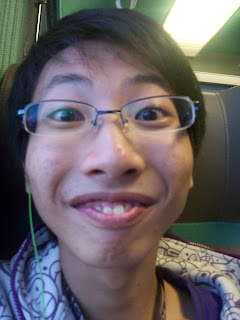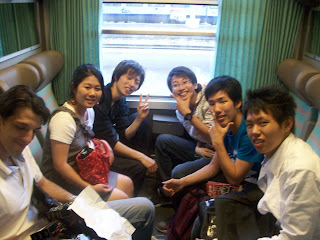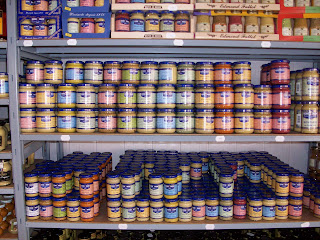

 XD
XD HAHA!!!
HAHA!!! Brother!!! Akaba
Brother!!! Akaba Really nothing to do.. so i take picture of myself...
Really nothing to do.. so i take picture of myself... ME!!!
ME!!! My brother (Akaba), Okuda and WeiLun
My brother (Akaba), Okuda and WeiLun Odysseas playing my PSP
Odysseas playing my PSP Had nothing to do. So take picture!!!
Had nothing to do. So take picture!!!Otsubo with 7up









 Sunset
Sunset
 Group Picture!!!
Group Picture!!! Me and my Brother!!!
Me and my Brother!!!Nut and Coco
 This is s stall selling Mustard and Vinegar
This is s stall selling Mustard and Vinegar Did you know??? Dijon is a town with 100 bell towers of which the highest and the most spectacular is Saint-benigne's (93m High)
Did you know??? Dijon is a town with 100 bell towers of which the highest and the most spectacular is Saint-benigne's (93m High) Admire the pure construction of the cathedral's choir nave which was typical for the Burgundy Gothic, and its flamboyant polychrome roof. From the time of the ancient abbey rebuilt from the year 1000 by Guillaime de Volpiano, the church features a crypt which is a master-piece of Romanesque Burgundian Art. It is here that the relic of Saint-Benigne, the 1st apostle of Burgundy, are to be found.
Admire the pure construction of the cathedral's choir nave which was typical for the Burgundy Gothic, and its flamboyant polychrome roof. From the time of the ancient abbey rebuilt from the year 1000 by Guillaime de Volpiano, the church features a crypt which is a master-piece of Romanesque Burgundian Art. It is here that the relic of Saint-Benigne, the 1st apostle of Burgundy, are to be found. The Layout of the building.
The Layout of the building. Checkpoint 22!!!
Checkpoint 22!!!This checkpoint is call Saint-Benigne.
 Checkpoint 21!!!
Checkpoint 21!!! Checkpoint 21!!!
Checkpoint 21!!!This checkpoint is call Saint-Philibert.
The porch of this ancient Saint-Philibert Church in the parish of the wine-growers served as a place for the election of the town's mayors until the French Revolution. This church was reconstructed during the full bloom of Romanesque Burgundian Art in the middle of the 12th century. During the revolution it become a storage room for salt.


 Checkpoint 20!!!
Checkpoint 20!!!This checkpoint is call Saint-Jean and Place Bossuet.
In the vicinity of the "rue Piron", the "Hotel fevret de St-Mesmin" invites you to discover the surprising diversity of the "Place Bossuet". Bossuet was born in Dijon in 1627. The discreet house where he was born huddles up to the foot of the Saint Jean Church a stones throw from his statue. The church was converted into a theatre in 1980 and welcomes the "Theatre Dijon Bourgogne, Centre Dramatique National".

 Checkpoint 19!!!
Checkpoint 19!!!This checkpoint is call Private Mansions. We can not find the building, Sorry!!!
Wander around the "Palais de Justice" at your own pace and discover the residences and private mansions which are representative of the parliamentarians of Dijon. The most famous is the "Hotel Legouz de Gerland" which is as impressive for its elegant facade on the "rue Vauban" as for its courtyard inspired by the neighbouring square, and the beautiful display of watch towers at the back, in the "rue jean-Baptiste Liegeard"
 Checkpoint 18!!!
Checkpoint 18!!!

 Checkpoint 18!!!
Checkpoint 18!!!This checkpoint is call Palais de Justice.
The "Palais de Justice" was designed for the old burgundy Parliament in the 16th century. It houses the Saint Louis room known as the "Salle des Pas Perdus" (the room of lost steps), with the remarkable Saint Esprit chapel and the "Chambre Doree" (Golden Chamber,) which is a public hearing room.
Did you know??? The "Salle des Pas Perdus" was one of Dijon's most lively places. Apart from anything else, it contained shops and the parliamentary delegates refreshment room.




 Checkpoint 17: The semicircular square designed in 1685 by Jules Hardouin Mansart to receive the equestrain statue of King Louis XIV, fits in well with the ensemble which makes up the "Plalis des Etats". One of the most beautiful royal squares in France.
Checkpoint 17: The semicircular square designed in 1685 by Jules Hardouin Mansart to receive the equestrain statue of King Louis XIV, fits in well with the ensemble which makes up the "Plalis des Etats". One of the most beautiful royal squares in France.Did you know??? Designed by Le Hongre in 1690, the equestrian statue of the sun king did not arrive in Dijon until 1725 due to the transport difficulties of the time. It is unfortunate that it finished by being melted down to make canons for the revolutionaries in 1792.
 The tower in the middle is checkpoint 16!!!
The tower in the middle is checkpoint 16!!!This checkpoint is call Tour Philippe le Bon.
The "Tour Philippe le Bon" dominates the town at a height of 46m. Erected in the middle of the 15th century, it symbolizes the prestige and power of the Dukes of Burgundy.
You will be rewarded for your effort by the magnificent panorama which can be seen from the roof.
 Checkpoint 17!!!
Checkpoint 17!!!This checkpoint is call Place de la Liberation.
 The present palace was orginally just a residence built against the Gallo-Roman Castrum. it was recostructed from 1366 onwards by Philip The Bold and enlarged by the other dukes. It was Philip the Good who was responsible for the dukes' residence and the "Tour de la Terrasse", which took his name today. The classic reconstruction of the place began in the 17th century according to the plans of Jules Hardouin Mansart, the Versailles architect. It was finished in the course of the 19th century. The whole building now houses the Town Hall and the Musee des Beaux Arts (Fine Arts Museum)
The present palace was orginally just a residence built against the Gallo-Roman Castrum. it was recostructed from 1366 onwards by Philip The Bold and enlarged by the other dukes. It was Philip the Good who was responsible for the dukes' residence and the "Tour de la Terrasse", which took his name today. The classic reconstruction of the place began in the 17th century according to the plans of Jules Hardouin Mansart, the Versailles architect. It was finished in the course of the 19th century. The whole building now houses the Town Hall and the Musee des Beaux Arts (Fine Arts Museum) Checkpoint 15!!!
Checkpoint 15!!!This checkpoint is call Palais des Ducs et des Etats de Bourgogne.
 Checkpoint 14!!!
Checkpoint 14!!!

 And this is me!!! Call Nut!!!
And this is me!!! Call Nut!!! This is my brother!!! Call Coco!!!
This is my brother!!! Call Coco!!! Haha!!! Praying to each other???
Haha!!! Praying to each other??? Checkpoint 14!!!
Checkpoint 14!!!This checkpoint is call Tour de Bar.
Designed according to the model of a medieval dungeon, the "Tour de Bar" was built from 1365 onwards by Philip The Bold. It is named after Rene d'Anjou, Duke of Bar and Lorraine and King of Hungary, Jerusalem and Sicily, who imprisoned in the tower from 1431 to 1437. It is the most ancient part of the Palace.
Did you know?? The dukes gave Dijon and Burgundy international fame by exercising one of the first patronages. One of the most famous artists of the era was Claus Sluter, auther of the "Puits De Moise" and of one of the tombs of the "Chartreuse De Champmol".
 This watchtower resembles a watch guard. The comparison is quite proper since in ancient French, the verb "escargaiter" meant "to watch". Echauguette is a derivation of "escargaiter". Ever since, these turrets have had a more decorative than defensive part.
This watchtower resembles a watch guard. The comparison is quite proper since in ancient French, the verb "escargaiter" meant "to watch". Echauguette is a derivation of "escargaiter". Ever since, these turrets have had a more decorative than defensive part. Checkpoint 13!!!
Checkpoint 13!!!This checkpoint is call Echauguette Berbis.

 The statue of J-P. Rameau : a tribute to one of the most important composers of the country born in Dijon in 1683.
The statue of J-P. Rameau : a tribute to one of the most important composers of the country born in Dijon in 1683. Musee des Beaux Arts (Fine Arts Museum) which has a plan of the Gallo-Roman Castrum on its facade evoking Divio, the first page in the history of Dijon.
Musee des Beaux Arts (Fine Arts Museum) which has a plan of the Gallo-Roman Castrum on its facade evoking Divio, the first page in the history of Dijon. Eglise St-Michel:
Eglise St-Michel:A break in the perspective of the town's main road. The first phase of the construction work is of gothic influence whereas the facade was inspired by the Italian Renaissance.
 Eglise St-Etienne:
Eglise St-Etienne:This ancient abbey-church of which the nave houses today the Vhamber of Commerce and Industry, and also the Musee Rude.
 Le theatre:
Le theatre:Built on the site of the "Sainte Chapelle", is witness to a whole era. Work of Jacques Cellerier, it was built in neo-classic style whis was very much in fashion at the beginning of the 20th century.
 Checkpoint 12!!!
Checkpoint 12!!!This checkpoint is call Place du Theatre.
There is 3 building in this place.







 Checkpoint 11!!!
Checkpoint 11!!!Checkpoint 10 and 11 is very close to each other. This checkpoint is call L'hotel de Vogue.
This is the best example of a 17th century town house between courtyard and garden. Its classic and moderate design combines all the decorative refinement of the Renaissance. It was built for parliamentary president Etienne Bouhier and passed by marriage to the "de Vogue" family in 1782. Then, having been acquired by the town, it is used today to host exhibitions, concerts and theatre presentations.
 Checkpoint 10!!!
Checkpoint 10!!!This checkpoint is call Maison Milliere.
This house was built in 1483 by the merchant Guillaume Milliere and it has kept its typical medieval appearance: street stall on the ground floor and dwelling of Milliere and his family on the first floor. The facade has retained its wooden-beamed walls fills with enameled bricks. However, the cat and the owl which dominate the roof date from the beginning of the 20th century.
Did you know??? This house was used as decor for many films, in particular for "Cyrano De Bergerac" with Gerard Depardieu.


 Checkpoint 9!!!
Checkpoint 9!!!This checkpoint is call The Owl.
Over the centuries, this owl has become a good luck charm for passers-by, who rub it with their left hand (the hand close to the heart). Be sure to make a wish as you give it a rub!
Did you know??? This Owl was severely damaged on its left side in the night of january 5th and 6th 2001. The inhabitants were very upset and said it was scandalous. Its restoration made amends for the outrage and now it is kept under watch day and night

 Inside of Notre Dame!!!
Inside of Notre Dame!!! This is inside of Notre Dame!!!
This is inside of Notre Dame!!! Checkpoint 8!!!
Checkpoint 8!!!




 Here is Checkpoint 8!!!
Here is Checkpoint 8!!!This checkpoint is Notre Dame.
A masterpiece of burgundy architecture of the 13th century, "Notre-Dame" has a remarkable facade, composed of fine arcatures and rows of false gargoyles. it is crowned by "Jacquemart", a war spoil of Philip The Bold, which still rhythms the life of the surroundings.
Did you know?? Just a few of the 13th century gargoyles remain on the sides. The legend pretends that a usurer who came to get married was crushed by one of the facade's gargoyles!
His successors obtained their removal.. It was not until 1881 that the sculptor lagoule was entrusted with the creation of the present false gargoyles.




 This is Checkpoint 6!!! Sorry i can not find the Owl... XD
This is Checkpoint 6!!! Sorry i can not find the Owl... XDThis checkpoint is call Place Francois Rude.
This square was constructed in 1904 after the demolition of the block of old houses.
It was named after a famous Dijon sculptor who was born at a stone's throw from here and who was the author of "La Marseillaise" the famous bas relief sculpted on the "Arc de Triomphe" in Paris.
 Mustard!!!
Mustard!!!They have all kind of mustard!!!
Berry mustard, cocao mustard etc...
 This is something like a flavouring for champange.
This is something like a flavouring for champange.
 This is Checkpoint 5!!! Sorry i can not find the Owl... XD
This is Checkpoint 5!!! Sorry i can not find the Owl... XDThis checkpoint is call Covered Market.
On market days (every Tuesday, Thursday, Friday and Saturday), this area comes to
life, ablaze with colour and fills with wonderful smells. The metal structure of the covered market looks the same today as it did when it was build.
Did you know? The building was implanted on the site of the old convent cloister of the jacobines of which the church was used for the market, before its demolition.
 This is something like a flavouring for champange.
This is something like a flavouring for champange. This is something like a flavouring for champange.
This is something like a flavouring for champange.




 Checkpoint 4!!!
Checkpoint 4!!!

 This is Checkpoint 4!!!
This is Checkpoint 4!!!This Checkpoint is Post Office/ Place Grangier
Grangier square bears witness to the innovative leanings at the beginning of the 20th century.
Next to the "Hotel de Postes", with its very academic architecture, is a surprising Art Nouveau building with pagoda roofs displaying its difference, despite the fact that it was designed by the same architect, Louis Perreau. The square takes its name from Henri and Sophie Grangier who benqueathed a large part of their fortune to the town of Dijon.




 Checkpoint 3!!!
Checkpoint 3!!!The picture is just above this picture. This checkpoint is Porte Guillaume.
This 18th century trumphal arch is named after Guillaume de Volpiano, the 11th century reformer of the Saint-Benigne Benedictine abbey.
Did you know?? Originally the "Porte Guillaume" was inserted in the town's ramparts.
It was not until the end of the 19th century with the demolition of the ramparts,
That it found itself isolated.
"Rue de la Liberte" one of the most important shopping streets in Dijon opens the
perspective from the "Porte Guillaume"
 Checkpoint 2!!!
Checkpoint 2!!!Sorry I never take picture of it. But this checkpoint is The facade of the "Hotel de la Cloche"
This luxury hotel was built in 1882 to accommodate the rich and powerful of the day,
between two legs of their journey on the "imperial" Paris-Lyon-Mediterranee
(PLM) railway line.
 This is what we are following on the ground. It guide us to the next checkpoint.
This is what we are following on the ground. It guide us to the next checkpoint.






 This was the town's first public garden, created in 1880.
This was the town's first public garden, created in 1880.It was designed around the reservoir constructed forty years earlier by the
engineer Henri Darcy to bring water to the town from Val Suzon.
This romantic garden is guarded by the "White Bear", which is a tribute to the famous animal
sculptor, Francois Pompon, whose works can be seen at the Musse des Beaux Arts (Fine Arts Museum). The place will look even nicer when its in winter time.
 This is the First Checkpoint!!! There are total of 22 Checkpoint
This is the First Checkpoint!!! There are total of 22 CheckpointThis Checkpoint is Jardin Darcy


 So first we go to the Tourism Information Center to know where to go...
So first we go to the Tourism Information Center to know where to go...

 Dijon!!!
Dijon!!!
No comments:
Post a Comment